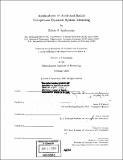Applications of axial and radial compressor dynamic system modeling
Author(s)
Spakovszky, Zoltán S. (Zoltán Sándor), 1972-
DownloadFull printable version (22.33Mb)
Other Contributors
Massachusetts Institute of Technology. Dept. of Aeronautics and Astronautics.
Advisor
James D. Paduano.
Terms of use
Metadata
Show full item recordAbstract
The presented work is a compilation of four different projects related to axial and centrifugal compression systems. The projects are related by the underlying dynamic system modeling approach that is common in all of them. Two types of models are introduced, suitable for modeling the dynamic behavior of axial and centrifugal compression systems: a compact single semi-actuator disk model, Model I, and a new modular multi semi-actuator disk model, Model II. The first project analyzes aerodynamically induced whirling forces in axial-flow compressors and a new unsteady low order model is introduced to predict the destabilizing whirling forces. The model consists of two parts: compressor Model I with the effect of tip-clearance induced distortion, and an aerodynamically induced force model. The modeling results are compared to experimental data obtained from the GE Aircraft Engines test program on compressor whirl. Previously outstanding whirl-instability issues are resolved, including prediction of the direction and magnitude of rotor whirl-inducing forces; such issues are important in the design of modern axial-flow compressors. (cont.) Additional insight is gained from the model on the effects of forced rotor whirl. In particular, a non-dimensional parameter is deduced that determines the direction of rotor whirl tendency in both compressors and turbines due to tangential blade loading forces. The second project is a first-of-a-kind feasibility study of an active stall control experiment with a mag- netic bearing servo-actuator in the NASA Glenn high-speed single-stage compressor test facility. Together with CFD and experimental data the tip-clearance sensitive compressor Model I was used in a stochastic estimation and control analysis to determine the required magnetic bearing performance for compressor stall control. A magnetic bearing servo-actuator was designed that fulfilled the performance specifications, setting a milestone in magnetic bearing development for aero-engine applications. Control laws were then developed to stabilize the compressor shaft. In a second control loop, a constant gain controller was imple- mented to stabilize rotating stall. A detailed closed loop simulation at 100% corrected design speed resulted in a 2.3% reduction of stalling mass flow which is comparable to results obtained in the same compressor using unsteady air injection. (cont.) The third project is the investigation of unsteady impeller-diffuser interaction effects on compressor stability. First, the unsteady blade-row interaction in axial compressors is analyzed using Model II. The results reveal a new signature of pre-stall waves that travel backward, altering the system dynamics when rotor and stator are moderately coupled. The physical mechanism for this behavior is explained from first principles and a coupling criterion is presented. The theory is then applied to centrifugal compressors and in particular to the NASA CC3 high-speed centrifugal compressor, in which experiments are conducted to verify the model predictions. The measurements show the predicted behavior and confirm the existence of backward traveling stall pre-cursors. The fourth project is an experimental demonstration of stability enhancement in the NASA CC3 high-speed centrifugal compressor with air injection. Based ...
Description
Thesis (Ph.D.)--Massachusetts Institute of Technology, Dept. of Aeronautics and Astronautics, February 2001. Includes bibliographical references (p. 255-262).
Date issued
2001Department
Massachusetts Institute of Technology. Department of Aeronautics and AstronauticsPublisher
Massachusetts Institute of Technology
Keywords
Aeronautics and Astronautics.